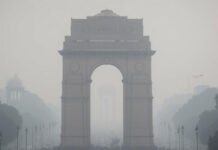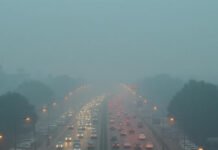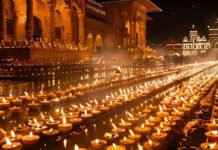New Delhi, October 23, 2025 – Delhi’s air quality remains in the ‘very poor’ category for the fourth consecutive day following Diwali celebrations, triggering widespread concern among residents and health authorities. The festival of lights, celebrated with widespread fireworks, has led to a sharp increase in particulate matter, pushing the Air Quality Index (AQI) to alarming levels.
According to the Central Pollution Control Board (CPCB), AQI readings in several parts of the city have exceeded 400, a level classified as “very poor,” which can cause respiratory issues and exacerbate existing health conditions. Areas such as Connaught Place, Anand Vihar, and Rohini have reported some of the highest pollution levels.
“The post-Diwali spike in air pollution is a recurring problem, and this year’s celebrations have further worsened the situation. We advise residents, especially children, the elderly, and those with respiratory conditions, to limit outdoor activities,” said Dr. Anupam Singh, environmental health expert.
Factors Contributing to the Pollution Spike
Fireworks and Crackers
Despite campaigns to reduce firecracker use, Diwali festivities remain a major contributor to air pollution in Delhi. Fireworks release large amounts of particulate matter (PM2.5 and PM10), sulfur dioxide, and other toxic gases, which linger in the atmosphere for days.Crop Stubble Burning
The burning of crop residue in neighboring states like Punjab and Haryana continues to add to the smog over Delhi, exacerbating the already poor air quality. Satellite data indicates significant plumes drifting toward the capital, contributing to the dense haze.Vehicular Emissions
Increased traffic during festive shopping and celebrations has added to the already high emissions of nitrogen oxides and particulate matter, further deteriorating air quality.Weather Conditions
Calm winds and low temperatures during late October trap pollutants close to the ground, creating a “pollution dome” that prevents dispersion. Meteorologists expect limited improvement until wind speeds pick up in a few days.
Health Advisory and Precautions
Authorities have issued a health advisory to minimize exposure:
Stay Indoors: Residents, especially children and the elderly, are advised to stay indoors as much as possible.
Use Masks: N95 or N99 masks are recommended for outdoor activities.
Air Purifiers: Using air purifiers indoors can help reduce particulate matter exposure.
Avoid Outdoor Exercise: High-intensity outdoor activities can increase the risk of respiratory issues.
Monitor Health Symptoms: Individuals with asthma, COPD, or heart conditions should monitor symptoms and seek medical help if necessary.
“Prolonged exposure to such high AQI levels can cause chronic respiratory problems, eye irritation, and cardiovascular issues. Preventive measures are critical during this period,” warned Dr. Meera Kapoor, pulmonologist at AIIMS, Delhi.
Government Response
The Delhi Pollution Control Committee (DPCC) and local authorities are taking measures to mitigate the crisis:
Air Quality Monitoring: Continuous monitoring of AQI levels across the city with public advisories.
Water Spraying and Dust Control: Municipal bodies are spraying water on major roads to reduce dust pollution.
Traffic Regulation: Implementation of odd-even vehicle rules is being considered if AQI remains above 400.
Awareness Campaigns: Social media campaigns urging citizens to reduce the use of firecrackers and practice eco-friendly Diwali celebrations.
Environmental Groups Speak Out
Environmental NGOs have criticized the lack of strict enforcement of firecracker bans and called for stricter regulations:
“Every year, despite awareness campaigns, Delhi suffers from post-Diwali pollution spikes. Authorities must enforce the ban on fireworks more strictly and encourage sustainable alternatives,” said Ramesh Agarwal, Director of Clean Air India Initiative.
Looking Ahead
Meteorologists predict slight improvement in air quality in the next week as wind speeds increase and rainfall is expected in parts of North India. However, sustained efforts to curb pollution sources, including vehicular emissions, industrial activity, and crop stubble burning, remain crucial to prevent long-term health impacts.
Conclusion
Delhi’s air quality crisis post-Diwali highlights the ongoing struggle between cultural festivities and environmental sustainability. With AQI levels remaining in the “very poor” category, authorities, residents, and environmental groups must work together to adopt measures that protect public health and promote cleaner air for future generations.
















